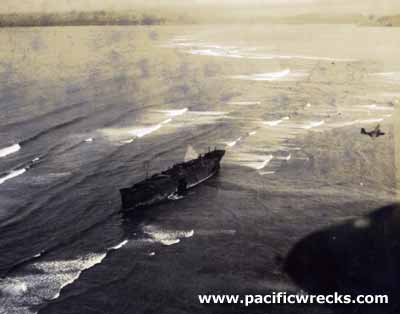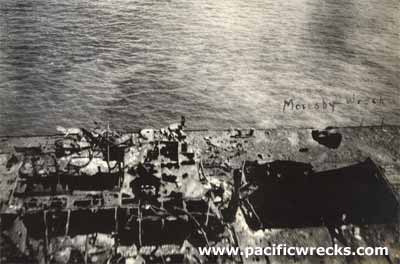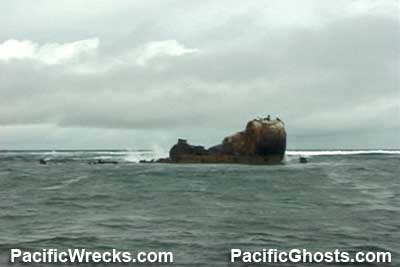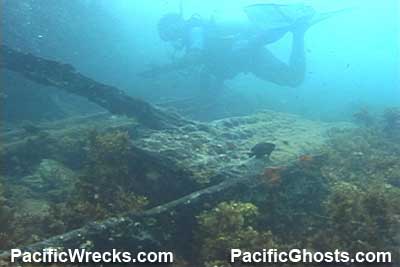|
|
|
|
| Missing In Action (MIA) | Prisoners Of War (POW) | Unexploded Ordnance (UXO) |
| Chronology | Locations | Aircraft | Ships | Submit Info | How You Can Help | Donate |
|
| British Steam Ship 4,698 Tons   5th AF c1943  43rd BG c1943   Justin Taylan 2005 |
Ship History Built by by J. L. Thompson and Sons in Sunderland, United Kingdom. Completed in 1916 as SS Pruth purchased by Hain Steamship Company based in Cardiff, Wales. In 1917 the company was purchased by P&O Steam Navigation Company but Hain continued to operate as a separate entity. SS Pruth was used for tramp service transporting cargo. During late 1923, SS Pruth under the command of Captain Matthew Hudson was on a voyage from New York via the Panama Canal then across the Pacific with a stop at Port Moresby then Cairns. Grounding On December 30, 1923 in the evening, SS Pruth was sighted bound for Basilisk Passage at the entrance of Fairfax Harbor and was to anchor off Port Moresby but ran aground on aground on Nateara Reef. On December 31, 1923 in the morning when ship had not arrived in was soon spotted on the reef. Salvage On January 1, 1924 at high tide, the ship was unable to free itself and Papua lakatoi (outrigger sailing canoes) were used to remove the cargo for Port Moresby including petroleum products in hopes of lightening the vessel. Still stuck on the reef, more cargo was removed and placed on nearby Local Island. Meanwhile, due to tidal action, the ship slid further onto the reef. As the prospect of freeing the ship became impossible all usable parts were removed before the ship was abandoned. Later, a Court of Inquiry into the incident determined Captain Matthew Hudson had made an error of judgment that resulted in running aground and the loss of the ship. Shipwreck Afterwards, the intact hull of SS Pruth became a landmark visible from the sea or Port Moresby. During 1934, used as a backdrop and set for the RKO Hollywood movie Red Morning (1934). In 1940, her funnel blew over. That same year, a Japanese company negotiated to purchase the shipwreck for scrap metal but the deal did not materialize. In 1941, Australians salvaged 200 tons of scrap metal from the wreck including one propeller. Wartime History During the Pacific War, the shipwreck remained largely intact and became known as the "Moresby Wreck" and was attacked by Japanese planes attacking Port Moresby and Allied aircraft flying training missions. On at least two occasions, Japanese aircraft attacking Port Moresby targeted the shipwreck. On February 28, 1942 A6M2 Zeros from the 4th Kokutai test fired their guns on the wreck, before strafing RAAF Catalina flying boats moored off Napa Napa. On March 25, 1942 a Japanese bomber bombed the shipwreck but missed. Between 1942 until 1943 the shipwreck was use for strafing and bombing practice for U.S. Army Air Force (USAAF) and Royal Australian Air Force (RAAF) aircraft. Also, the development of new bombing techniques including skip bombing and to test new bomb configurations. While used as training target, seven Allied aircraft were lost and twenty Allied personnel killed between November 10, 1942 until September 29, 1943. The seven aircraft lost attacking the SS Pruth shipwreck include: 1. On November 10, 1942 lost DB-7 Boston A28-12 exploded mid-air over the wreck, killing all three crew. 2. On February 5, 1943 lost B-25 41-12502 hit the mast and crashed killing all three crew. 3. On February 21, 1943 damaged B-25C "Draft Dodger" 41-12968 by bomb blast ditched without fatalities. 4. On April 22, 1943 damaged A-20A "Strawberry Roan" 40-173 damaged and ditched without fatalities. 5. On May 31, 1943 lost Beaufighter A19-73 hit the mast and crashed, killing two crew with two survivors. 6. On July 27, 1943 lost B-25D 41-30496 crashed killing all five crew. 7. On September 29, 1943 lost B-25D 41-30053 crashed killing all seven crew. Postwar Sometime during the postwar era, the shipwreck was used as a training aid, the remaining wreckage was scrapped to the waterline. By the early 1970s, only the ship's boilers and a portion of the stern were above the surface. On a clear day the wreckage was still visible from Port Moresby, Ela Beach to Koki. As of 2005, Underwater, only broken remains of the ship too difficult to salvage or scrap still remain on the reef in shallow water. Few pieces are recognizable aside from a few port holes, gears and bolts visible. From the air, the outline of the ship is still visible and the three boilers. Reportedly, local fisherman have salvaged bullets and unexploded bombs from around the shipwreck. Display Reportedly, the ship's bell was recovered and in the 1960s or early 1970s displayed at the colonial museum below the House of Assembly in Port Moresby. Afterwards, this bell was not added to the collection of the National Museum & Art Gallery (NMAG) or the PNG Modern History department. Bruce Hoy adds: "The Bell from the SS Pruth is reported to have been saved and preserved in 'the Museum' at Port Moresby, but [I] never sighted it at the time [I] joined the museum in 1978 and accepted the artifacts that had been in the colonial museum below the House of Assembly in downtown Port Moresby that included a diary door from C-47 "Flying Dutchman" 41-18564." References Wrecks & Reefs (1994) pages 208-220 Seek & Strike (2002) page 19 "bombers came in 0915 on 25 March, and ground observers thought one was hit by anti-aircraft fire, as it left formation and bombed the old wrecked ship, the SS Pruth, but missed." Thanks to Bruce Hoy for additional information Contribute
Information |
S 9 E 147 |
| Discussion Forum | Daily Updates | Reviews | Museums | Interviews & Oral Histories |
|